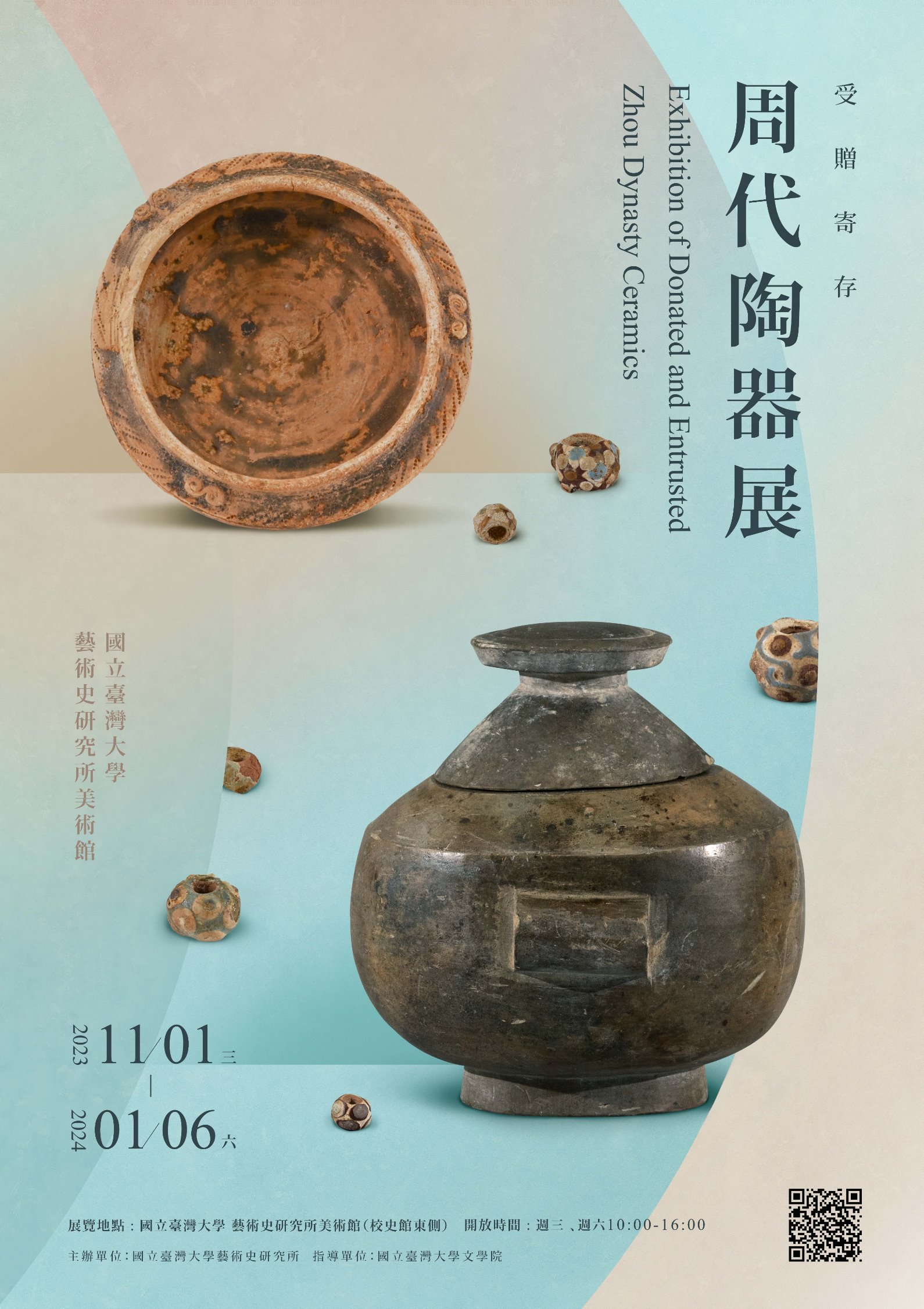受贈寄存 周代陶器展 Nov.01.2023 - Jan.06.2024

展出期間:Nov.01.2023-Jan.06.2024
展覽地點:國立臺灣大學 藝術史研究所美術館(校史館東側)
開放時間:週三、週六 10:00-16:00
「受贈寄存 周代陶器展」簡介
中國在至今一萬多年前已經開始生產陶器,燒造高溫施釉器的歷史也有三千多年之久,此次展出的陶瓷器則是框定在周代,即自西周(1046B.C.‒771 B.C.)到戰國時期(1046 B.C.‒221 B.C.)。這包括在攝氏700~800度燒成的低溫陶器(灰陶、黑陶和釉陶),以及以攝氏1200度左右高溫製成的炻器(含高溫無釉製品和灰釉器)。後者高溫灰釉炻器有時又被稱為「原始瓷器」或「原始青瓷」。
西周陶器以表飾繩紋的鬲最具代表性,其中有以三足模成形的分襠鬲和以手捏製的聯襠鬲,有的內底仍留有煙炱,可知是實用的炊具。隨著陶釜的風行,鬲到戰國時期已近尾聲,展出的幾近平襠的錐足鬲即為其例。為了參考比較,也陳列了幾件屬燕山南北早期青銅文化遺存、距今三千多年的夏家店下層文化陶鬲。
展出的西周至戰國時期灰釉器,均屬富含氧化鈣的石灰釉,它們是由長江下游今浙江省瓷窯所燒造,屬於廣義的越窯製品。展出的無釉印紋炻器的胎質化學組成和同時期的灰釉器大致相同,且多數是以高溫燒成,敲之可發出清脆的聲響。在成形工法上,一般都是以泥條盤築成形,而後內襯抵手,再以帶刻紋的拍具打拍外壁,此既可使泥條粘結緊密,同時留下各類的印紋。長江以南和東南沿海地區都燒造有這類又被稱為幾何形印紋硬陶的製品,不過此次展出的作品均來自今浙江省一帶窯場所燒造。
另外,展出的幾件在陶胎上塗飾「玻璃漿料」的釉陶珠,乃是模倣由西方傳入中國的玻璃蜻蜓眼,類似的釉陶珠見於河南或湖北等地戰國墓,是洋溢著異國風情討人喜愛的裝飾具。
(此次受贈寄存作品,是來自章建行先生以及謝明良、李月桂夫婦二人的收藏,謹此說明。)
Donated and Entrusted Zhou Dynasty Ceramics
Introduction to the Exhibition
Chinese ceramic production can be traced back to more than ten thousand years ago, with an over three-thousand-year history of high fire glazes. The collection of Chinese ceramics presented in the exhibition are artifacts of Zhou dynasty, which is from the Western Zhou dynasty (1046 B.C. to 771 B.C.) to the Warring States Period (1046 B.C.to 221 B.C.). These ceramic vessels include potteries fired with a lower temperature between 700 and 800 degrees Celsius (the gray, black and glazed potteries), and stoneware high fired at around 1,200 degrees Celsius (the unglazed ware and ash-glazed vessels). Among these, the ash-glazed stoneware is sometimes described as "proto-porcelain" or "proto-celadon".
The iconic pottery from the Western Zhou period is Li, a kind of cooking vessel decorated with cord-marked pattern. There are Li tripods with divided crotches as well as those with joined crotches formed by hands. Some of them are found with remaining scoot deposits inside, which indicates that they were used as cookware. As ceramic cauldron became prevalent in the Warring States Period, the typical Li faded out. This trend is demonstrated in the displayed Li vessel with level crotch. To serve as a comparison, several remains of ceramic Li from the early Bronze Age found in the northern and southern Yanshan regions are also on display. These objects belong to the Lower Xiajiadian culture that existed more than three thousand years ago.
All the displayed ash-glazed objects are made with ash glaze that contains a high amount of calcium oxide. They are produced through the kilns located in the lower Yangtze River Valley, today's Zhejiang Province, and can be in general categorized as Yue ware. The unglazed, impressed stoneware on display has a chemical composition in its body similar to the ash-glazed ware of the same period. Most of these objects are high fired and produce a crisp sound when knocking on the object. In terms of forming technique, the pottery is first shaped by building up clay coils, and then with a support on the inside, paddled on the exterior with tools bearing patterns. This kind of forming method works to bond the coils tightly, while leaving various patterns. Similar geometric-impressed pottery products are found in both south of the Yangtze River and areas along the southeastern coast of China. However, all the artifacts on display come from the kilns in Zhejiang Province.
The exhibition also displays several glazed ceramic beads, which are processed by applying glass paste to the earthenware. These beads are inspired by dragonfly eye beads introduced from the Western to China and have been found in Warring States Period graves in places like Henan and Hubei. With exotic charm, these attractive items serve the purpose of decoration.
The objects in this exhibition are donations and entrusted by collectors Mr. Chang Chien-hsing, Mr. and Mrs. Hsieh Ming-liang.
